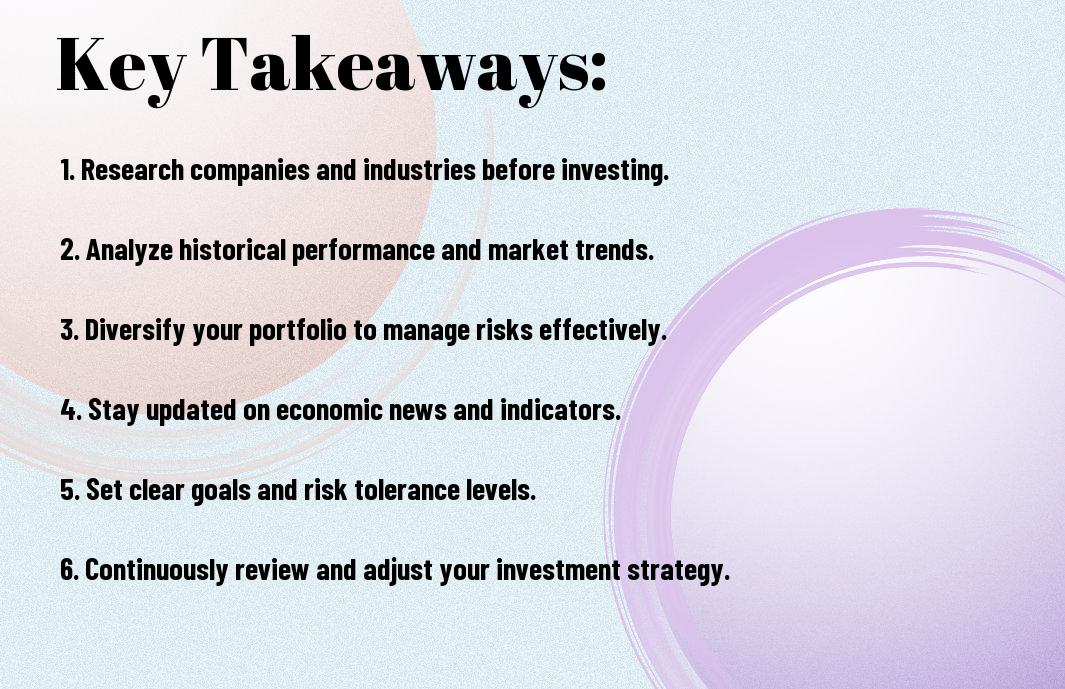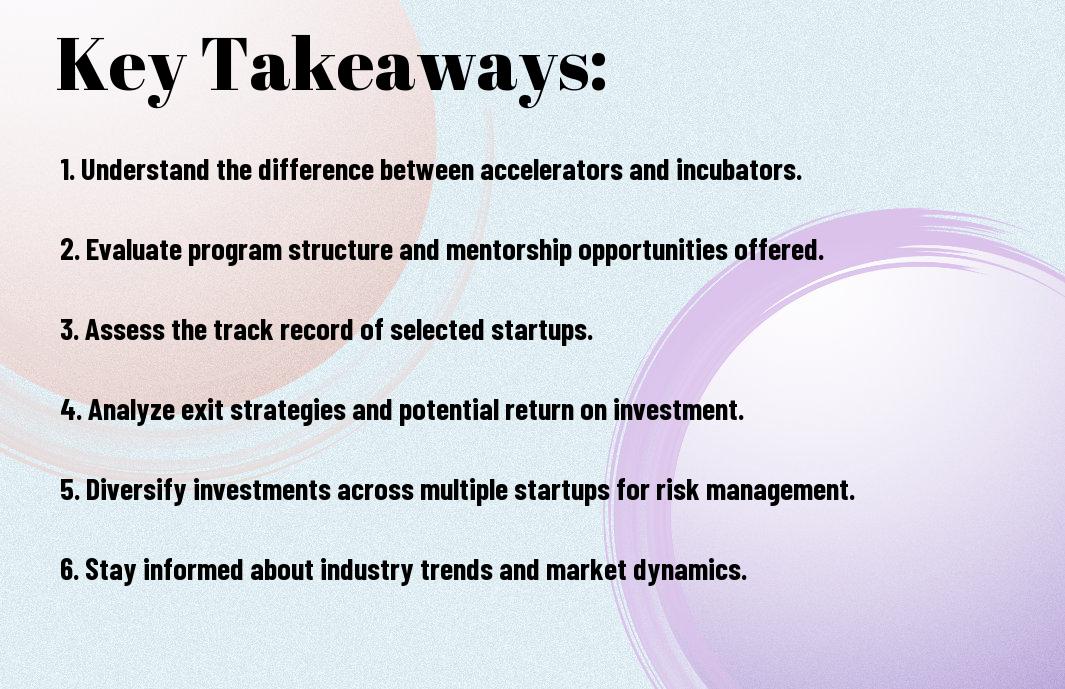Over the years, stock market investing has become an accessible way to grow your wealth, but making informed decisions is crucial for success. Understanding how to analyze market trends, evaluate a company’s performance, and interpret financial data can enhance your investment strategy. You can improve your decision-making skills by learning the fundamentals, and you can start by exploring resources like How to analyse a stock to make informed investment decisions. In this post, we will guide you through the key steps to empower your investing journey.
Key Takeaways:
- Research: Conduct thorough research on companies, industries, and market trends before making any investment decisions.
- Diversification: Spread investments across different asset classes to mitigate risk and enhance potential returns.
- Long-term Perspective: Focus on long-term financial goals and avoid making impulsive decisions based on short-term market fluctuations.

Understanding the Stock Market
While navigating the complexities of the stock market can seem intimidating, having a solid grasp of its structure is vital. The stock market serves as a platform where buyers and sellers trade shares of publicly listed companies. Your understanding of how the market functions will empower you to make more informed investment decisions and enhance your potential for long-term gains.
Market Fundamentals
Stock markets operate through exchanges, where shares are bought and sold. These exchanges, such as the New York Stock Exchange and NASDAQ, facilitate the trading process and ensure transparency. To effectively engage with your investments, you need to familiarize yourself with how these exchanges operate, the roles of market makers, and the significance of market orders versus limit orders.
Key Terminology
For effective communication in the stock market, you must understand vital terminology. This includes concepts like equity, dividends, bull and bear markets, and market capitalization. Familiarizing yourself with these terms will not only enhance your understanding of investment strategies but also enable you to engage more meaningfully in discussions around market trends and investment opportunities.
Indeed, knowing key terminology is vital for you to interpret market news and reports accurately. Terms such as “dividend” reflect the income you can earn from your investments, while “bull” and “bear” describe overall market trends. By mastering this vocabulary, you enable yourself to analyze investment scenarios more critically and improve your decision-making process in stock market ventures.

Researching Investments
Even the most seasoned investors understand that thorough research is vital before making investment decisions. By digging deep into potential stocks, you empower yourself to build a well-informed portfolio. This process involves assessing various financial indicators, market trends, and economic factors, helping you make choices that align with your financial goals and risk tolerance.
Fundamental Analysis
Across the landscape of investment research, fundamental analysis serves as a foundational tool for evaluating a stock’s intrinsic value. This method involves examining a company’s financial statements, earnings, and competitive position within its industry to determine its overall health. By focusing on these core elements, you can identify stocks that are undervalued or overvalued, guiding your investment decisions.
Technical Analysis
Above fundamental evaluation, technical analysis focuses on price movements and trading volumes to predict future market behavior. By studying charts and patterns, you can gain insights into short-term price fluctuations and overall trends, which can be beneficial in timing your investments.
But unlike fundamental analysis, which is driven by a company’s financial health, technical analysis relies on historical data and market psychology. This approach enables you to identify entry and exit points by recognizing patterns, support and resistance levels, and market sentiment. Understanding these techniques can enhance your trading strategy, allowing you to make decisions based on market movements rather than just financial performance.
Evaluating Risk Tolerance
Unlike the notion that all investors share the same appetite for risk, your individual risk tolerance plays a pivotal role in stock market investing. This personal metric is shaped by factors such as your financial situation, investment horizon, and emotional response to market volatility. Understanding your risk tolerance helps you tailor your investment strategy to align with your comfort level, ensuring decisions that reflect your personal financial landscape.
Assessing Personal Financial Goals
To effectively navigate the stock market, you must first assess your personal financial goals. This includes identifying what you aim to achieve through investing, whether it’s saving for retirement, buying a home, or funding education. Clearly defined objectives will guide your investment strategy, helping you determine the appropriate level of risk you are willing to take on to meet those goals.
Diversification Strategies
Above all, leveraging diversification strategies can substantially mitigate risk in your investment portfolio. By spreading your investments across various sectors, asset classes, or geographic locations, you reduce the impact of poor-performing assets on your overall financial health. This balanced approach allows you to capture opportunities while safeguarding against market fluctuations that could otherwise derail your progress.
Evaluating diversification strategies involves assessing the right mix of investments to align with your risk tolerance and financial goals. You should consider diversifying among stocks, bonds, and alternative assets to create a more resilient portfolio. Additionally, investing in different industries and regions can help protect you during economic downturns. Regularly reviewing and rebalancing your portfolio ensures that it remains aligned with your risk profile and changes in market conditions, ultimately enhancing your investment strategy’s effectiveness.
Utilizing Tools and Resources
Many investors overlook the value of using various tools and resources to enhance their stock market decision-making. By incorporating the right platforms into your research process, you can significantly improve your ability to evaluate stocks and make informed trades. Whether you’re learning about market trends or analyzing specific companies, having the right resources at your fingertips can give you the edge you need in today’s dynamic investing environment.
Financial News and Analysis Platforms
Any investor knows that staying updated with financial news is imperative for making informed decisions. Platforms that provide real-time news, expert analysis, and insightful commentary can aid in understanding market conditions and key events impacting stocks. By following reputable sources, you can position yourself to act when opportunities arise or avoid potential pitfalls.
Stock Screening Tools
At your disposal are powerful stock screening tools that help you filter and analyze stocks based on specific criteria. These tools allow you to set parameters such as market capitalization, price-to-earnings ratio, and dividend yield, streamlining your research process. By using stock screeners, you can quickly identify investment opportunities that align with your strategy.
Consequently, utilizing stock screening tools not only saves you time but also provides clarity in a crowded market. You can tailor your searches according to your investment preferences, which helps pinpoint stocks that fit your risk tolerance and financial goals. This targeted approach enhances your decision-making process, enabling you to invest with confidence based on data-driven insights.
Developing a Decision-Making Process
Keep your investment decisions systematic by developing a well-defined decision-making process. This process should include gathering relevant data, analyzing market trends, and evaluating your emotional response to fluctuations. By establishing a structured approach, you can minimize impulsive decisions driven by fear or greed, ensuring you remain focused on your long-term strategies.
Creating an Investment Plan
Before you examine stock market investing, it’s crucial to create a comprehensive investment plan. Evaluate your financial goals, risk tolerance, and investment horizon. This plan serves as a roadmap, helping you stay aligned with your objectives and guiding your decisions based on your unique circumstances.
Setting Entry and Exit Strategies
On your investment journey, developing clear entry and exit strategies is vital for maximizing returns and minimizing losses. Establish criteria for when to buy or sell based on your analysis of market conditions, as well as your investment plan. This disciplined approach enables you to act rationally, rather than reacting emotionally to market fluctuations.
Hence, setting robust entry and exit strategies allows you to seize opportunities while managing risks effectively. Determine specific price points or percentage changes that will trigger buy and sell decisions. This kind of foresight helps you avoid potential regrets from late actions and keeps you grounded in your investment plan, ensuring your decisions align with your broader financial goals.
Keeping Emotions in Check
Once again, maintaining emotional detachment is vital for successful investing. When emotions like fear and greed come into play, your decision-making can become clouded, leading to impulsive actions. You should strive to create a structured investment strategy that allows for objective assessments of the market. By setting clear goals and sticking to your plan, you can minimize emotional interference and improve your overall investment performance.
Psychological Aspects of Investing
Below the surface of every investment interaction lies a complex web of psychological factors that can influence your choices. Understanding these aspects, such as overconfidence, loss aversion, and market biases, is key. You must assess how these psychological elements can sway your decisions, drawing you away from rational thinking and potentially costly mistakes.
Avoiding Common Behavioral Pitfalls
Among the various challenges you face as an investor, behavioral pitfalls can significantly hinder your success. Recognizing tendencies like herd mentality or chasing past performance is important. These behaviors may push you to make poor investment choices that deviate from your strategy.
Keeping a clear perspective is vital for avoiding these common behavioral pitfalls. Focus on developing discipline in your investment approach; this means sticking to your research and strategy, regardless of market noise. Regular self-reflection can also help you identify emotional triggers that may affect your decision-making. By adopting a systematic methodology, you can greatly reduce the likelihood of falling into these traps and enhance your investment outcomes.
Conclusion
Conclusively, to make informed decisions in stock market investing, you must conduct thorough research, evaluate financial statements, and consider market trends. Educate yourself on various investment strategies and stay updated with economic indicators that could impact your portfolio. By diversifying your investments and understanding your risk tolerance, you can build a robust investment approach tailored to your goals. Ultimately, remaining disciplined and patient will empower you to navigate the stock market with confidence and achieve long-term success.
FAQ
Q: What are the key factors to consider when making stock market investment decisions?
A: When making stock market investment decisions, it’s important to analyze several key factors. Firstly, consider the company’s financial health by reviewing its earnings reports, debt levels, and cash flow statements. Secondly, assess the broader market conditions, including interest rates and economic indicators that may affect stock performance. Lastly, evaluate the industry trends and competitors to understand the stock’s potential growth. Conducting thorough research and staying informed can help you make more confident decisions.
Q: How can I use fundamental analysis in my investment strategy?
A: Fundamental analysis involves evaluating a company’s intrinsic value based on its financial statements and market position. To apply this method, start by examining important metrics such as price-to-earnings (P/E) ratio, earnings per share (EPS), and dividends. Additionally, take into account qualitative factors, such as management effectiveness and market share. By comparing these metrics with industry averages and historical performance, you can identify whether a stock is undervalued or overvalued, aiding you in your investment choices.
Q: What role does diversification play in reducing risk when investing in stocks?
A: Diversification plays a significant role in reducing risk by spreading investments across various sectors, asset classes, or geographic regions. By not placing all your capital into a single stock, you can mitigate the impact of poor performance in any one investment. A well-diversified portfolio can provide more stable returns over time, as different investments may respond differently to market conditions. Consider incorporating a mix of stocks, bonds, and other asset types to optimize your investment strategy and enhance overall portfolio resilience.



